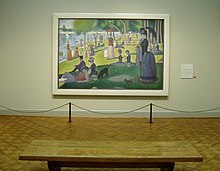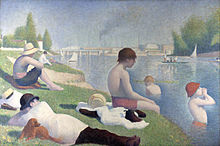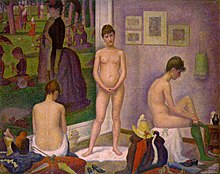A Sunday afternoon on the island of La Grande Jatte

|
| A Sunday afternoon on the island of La Grande Jatte |
|---|
| Georges Seurat , 1884–1886 |
| Oil on canvas |
| 207.6 x 308 cm |
| Art Institute of Chicago |
A Sunday afternoon on the island of La Grande Jatte (French: Un dimanche après-midi à l'Île de la Grande Jatte ) is a painting by the French painter Georges Seurat (1859–1891) from 1884–1886. The picture assigned to post-impressionism hangs in the Art Institute of Chicago today .
description
The picture shows people from different social classes under a bright summer sky on the banks of the Seine in Paris in the late 19th century. The Île de la Jatte is a two-kilometer-long Seine island in the west of Paris.
From the left front are shown:
- foreground
- a pipe-smoking canoeist,
- a middle-class couple with a top hat and hat,
- a black dog,
- a jumping little dog
- a couple in statue-like austerity (the woman with a monkey on a leash)
- Middle ground
- Angler with a friend watching
- a wet nurse and an elderly man under a parasol,
- a young woman with a red parasol and a small child dressed in white
- two girls (one with a parasol, the other with a bouquet of flowers)
- background
- a man with a trumpet,
- two soldiers,
- a skipping girl
- a couple embracing
- further, hardly recognizable figures.
- Several sailboats and a rowboat with four men and a helmswoman holding a parasol.
comment
Seurat largely avoided overlapping the sitter so that they appear like silhouettes. Any spontaneity is banned from the picture, so that the people appear like rigid dolls. The French author Pierre Courthio described Seurat as a “painter of the vertical” and commented on his style: “It was rightly said that almost every figure in Seurat's pictures looked as if they had been told over and over again: 'Stay straight! '“
Through the technique of pointillism , the picture consists of tiny dots, as if set in a grid. Charles Angrand , who watched Seurat work on the picture, reports on his painting style: "There was always order on Seurat's palette: three strands of white next to the thumb, each intended for mixing with one of the three primary colors red, yellow, blue." He matched the colors according to gradations of light-dark, warm-cold and the complementary colors. The mixture, the overall picture, only emerges in the eye of the beholder.
In this picture, Seurat applied the theory of optical mixing through the decomposition of colors for the first time with scientific rigor. The art critic Jules Christophe wrote in 1890 in the Seurat number 368 of the magazine Les Hommes d'aujourd'hui (German: "The people of today") in an article that Seurat personally helped to create:
“One afternoon under a shimmering summer sky, we see the glittering Seine, elegant villas on the opposite bank, small steamships gliding along the river, sailing boats and a rowboat. Under the trees, very close to us, people go for a walk, others sit or lie lazily in the bluish grass. Some fish. We see young girls, a nanny, an old grandmother under a parasol who looks like Dante, a boatswain who is lazily stretched out and smokes his pipe and whose pant legs are literally devoured by the bright sun. A dark purple dog sniffs the grass, a red butterfly flies around, a young mother goes for a walk with her little daughter, who is dressed all in white and wears a salmon-colored sash. Two cadets from the Saint-Cyr Military School stand near the water. A young girl is making a bouquet; a child with red hair and a blue dress is sitting in the grass. We see a married couple with their baby and on the far right the hieratic, sensational couple, a young dude with his elegant companion on his arm, who leads a purple-ultramarine monkey on a leash. "
history
Seurat completed The Bathers in Asnières (Baigneurs à Asnières) in 1884 , which were rejected by the jury of the Paris Salon . In the summer of the same year he began his preparatory studies for A Sunday Afternoon on the Island of La Grande Jatte . In December he exhibited The Bathers again at the Indépendants , along with studies on the Grande Jatte .
Seurat himself stated in a letter that he began both the study and the Grande Jatte painting on Ascension Day 1884 . He recorded his impressions on small wooden boards and transferred them to the canvas in the studio. But there was still a long way to go before the final version. Some elements have been removed, others changed, others added. So the woman walking with the monkey on a leash took the place of the seated woman in the foreground.
In March 1885 he completed the Grande Jatte , which he had been working on all winter. In the final version, the reclining man with a jockey cap is continued, as are the figures in the background. The picture has gained in clarity and precise design, but it lacks any spontaneity.
From May 15 to June 15, Seurat took part in the last group exhibition of the Impressionists , where Grande Jatte caused a stir. Arsène Alexandre reported on the public's reaction to this picture:
“At first sight, the viewer was frightened. Everything was new about this huge picture: the bold conception and the technology that nobody had previously had any idea of. So that was the famous pointillism. "
The picture was shown in the Salon des Indépendants, where the reactions were also violent:
“There was a lot of shouting, but victory was waiting on the battlefield. The success was immediately celebrated in La Vogue, in a clever, logical and knowledgeable essay by Félix Fénéon . "
In the spring of 1885, Seurat revised the painting. In 1888 he completed the large version of Die Modelle , which shows La Grande Jatte in the background .
Painting materials
Seurat's innovation was not in the use of special paints, but in the way they were used. He used the usual pigments of his time, such as Schweinfurt green , cobalt blue or cinnabar .
He also used the pigment zinc yellow , which was new at the time , mainly for the sunlit grass in the center of the composition. However, this pigment is highly unstable and changes its color to a dirty orange-brown, which was noticeable a short time after the painting was completed. The knowledge about the nature of the discoloration of this pigment was combined with the research results on the natural aging of the pigments and used for a digital makeover for this painting.
reception
The image provides the basis for Stephen Sondheim's Broadway musical Sunday in the Park with George (1984) , which is considered one of the composer's most important works and has won several awards, including the Pulitzer Prize , two Tony Awards and the Laurence Olivier Award .
New York artist James Rizzi designed Sunday Afternoon On The Island Of La Grande Jatte as a 3D work of art.
Provenance
After Seurat's death in 1891, the painting was in the possession of Seurat's mother († 1899). In 1900 the brother Émile Seurat sold it for 800 francs to Casimir Brû, who passed it on to his daughter Lucie Cousturier . This sold it in 1924 to the Vildrac Gallery, Paris. Vildrac sold it to Chicago collectors Frederic Clay and Helen Birch Bartlett that same year for about $ 20,000. In 1926 the painting was donated to the Art Institute of Chicago.
literature

- Pierre Courthion: Georges Seurat . DuMont, Cologne 1991, ISBN 3-7701-2701-3 .
- Jean-Louis Ferrier: The Adventure of Sight. An art history in 30 pictures. Piper, Munich / Zurich 1998, ISBN 3-492-04019-5 .
- Rolf H. Johannsen: 50 classics. Painting. The most important paintings in art history. Gerstenberg, Hildesheim 2001, ISBN 3-8067-2516-0 .
- Wieland Schmied (Ed.): Harenberg Museum of Painting: 525 masterpieces from seven centuries. Harenberg-Lexikon-Verlag, Dortmund 1999, ISBN 3-611-00814-1 .
Web links
- Video guide for the painting at the-artinspector.de
- Art Institute of Chicago : Seurat and the Making of La Grande Jatte. (archived version on archive.org )
Individual evidence
- ↑ a b c d Pierre Courthion: Georges Seurat . DuMont, Cologne 1991, ISBN 3-7701-2701-3 .
- ^ Inge Fiedler: A Technical Evaluation of the Grande Jatte. Art Institute of Chicago Museum Studies, Volume 14, No. 2, The Grande Jatte at 100 (1989), pp. 173-179, and others. 244-245 ( JSTOR 4108750 ).
- ^ Georges Seurat, 'A Sunday Afternoon on the Island of La Grande Jatte'. In: Colourlex.com.
- ↑ Kim Pilkjær Simonsen et al: Single crystal X-ray structure of the artists' pigment zinc yellow. In: Journal of Molecular Structure. Volume 1141, August 5, 2017, pp. 322–327, doi : 10.1016 / j.molstruc . 2017.03.108 .
- ↑ Francesca Casadio et al: Deterioration of zinc potassium chromate pigments: elucidating the effects of paint composition and environmental conditions on chromatic alteration . In: Janet Bridgland (Ed.): ICOM Committee for Conservation 15th Triennial Conference New Delhi Preprints . tape 2 . Allied Publishers, New Delhi 2008, ISBN 978-81-8424-346-8 , pp. 572-580 (English, limited preview in Google Book Search).
- ^ Roy S. Berns et al .: Rejuvenating the color palette of Georges Seurat's A Sunday on La Grande Jatte — 1884 : A simulation. Color Research & Application, 31 (4), pp. 278-293, doi : 10.1002 / col.20223 .
- ↑ Examples of a digital rejuvenation of the painting. Website by Roy S. Berns, Rochester Institute of Technology.
- ^ Sunday in the Park with George in the Internet Broadway Database .
- ↑ Sunday Afternoon On The Island Of La Grande Jatte at bulle8.de.
- ^ Art Institute Chicago, Provenance . artic.edu, accessed June 12, 2019.




